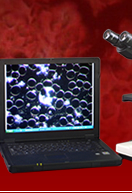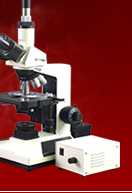
What an Amoeba Looks Like: Simple Experiments under a Compound Microscope
The amoeba is perhaps the oddest animal that can be found in the microscopic world. What makes the amoeba peculiar is that it does not have any eyes, mouth or stomach. Therefore it can be one of the most interesting biological specimens we can examine using a microscope. Teachers and students can perform this microscope activity in their elementary and high school science class.Amoeba thrives in aquatic plants at ponds or shallow pools. However, they are very difficult to obtain because they can be very hard to see with the naked unaided eye. An amoeba only measures about 1/100 inch diameter. Instead of painstakingly looking for an amoeba at each drop of pond water under a high power microscope, we can culture our own specimens in our high school science classroom laboratory.
To obtain your own amoeba, you must collect a mass of pondweed and place it in a petri dish. A petri dish is a container used often in microbiology for growing cell cultures that can later be viewed by an inverted tissue culture microscope. Cover the pondweed with water and place it in a location where there is no sunlight. Let it stand until a brown scum appears. This brown scum contains a number of amoeba. Transfer some of the amoeba to a microscope slide with a dipping tube. Put a cover slip over the amoeba to protect the microscope objective from the living biological specimen.
Under a high power microscope, the amoeba looks like a colorless jelly with an irregular shape. The amoeba moves slowly and changes its shape while altering its course. It protrudes long, blunt, finger-like projections from various parts of its body that can be drawn out or withdrawn at will. These finger-like projections of the amoeba’s body is called the pseudopodia or false legs.
With the use of a compound light microscope, you will see that the amoeba is divided into two regions. The colorless region is called the ectoplasm while the granular region is called the endoplasm. In the endoplasm you will see a round and slightly large structure that is the nucleus. The nucleus is vital to the amoeba as well as all other life forms. If you cut the amoeba, into two, the part without the nucleus will die.
Through the scientific microscope, you will also see a clear space within the endoplasm. This is called the contractile vacuole and it removes the water that is absorbed through the body’s surface.
You can feed the amoeba with vegetable matter and microscopic animals. Interesting enough, the amoeba doesn’t have any mouth to eat. It will be very lucky if there is food around the amoeba so that the students or children will be able to witness how the amoeba consumes its food.
Suppose that there is food with the amoeba in the microscope slide. Through a high power compound microscope, you will see that the amoeba’s finger-like projections expands towards the food. The rest of the amoeba follows until it totally surrounds the morsel. This is how the amoeba eats and it can consume its food with any part of its body.
We have observed under an educational compound microscope that the amoeba doesn’t have any stomach. What the amoeba does to its food is to form a food vacuole. This vacuole is consisted of the food particles which are suspended in water. A mineral acid is then secreted into this vacuole and it dissolves the food. The undigested particles are then left behind as the amoeba moves about.
As the amoeba takes in more food than it excretes, it grows in size. The amoeba’s growth size seldom reaches 1/100 inch in diameter but when it is already near that size, the amoeba is already considered mature. Teachers may want to tell the students and children to observe this stage of the amoeba under their scientific microscope. They will see that the mature amoeba will divide into two and finally become two separate amoebas.
Observing an amoeba under the high power compound light microscope will help high school and elementary students to learn more about the wonders of the microscopic world. The amoeba is such an odd creature that it will truly facinate students. This is therefore a highly recommended microscope experiment for those studying biology and wanting to know more about the unseen microworld.




